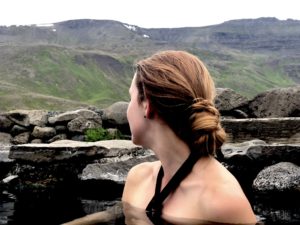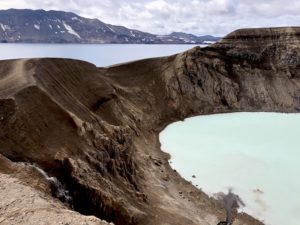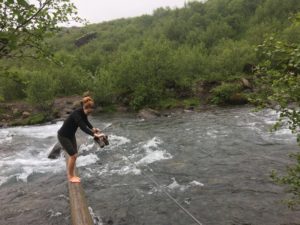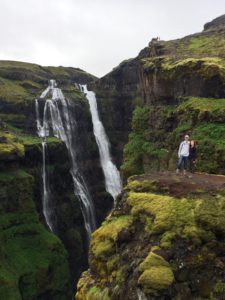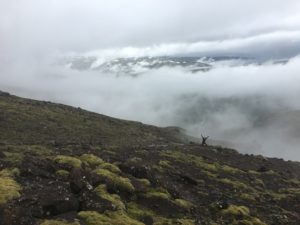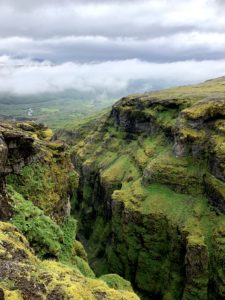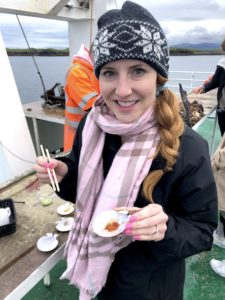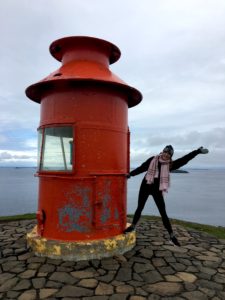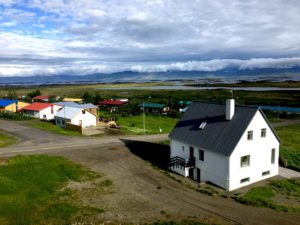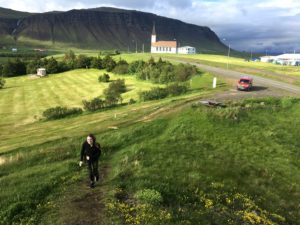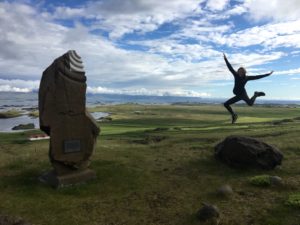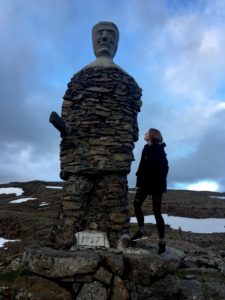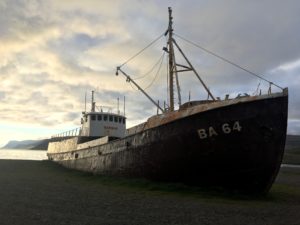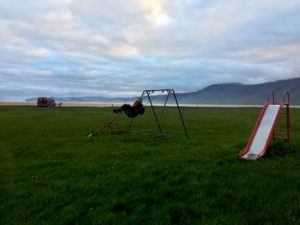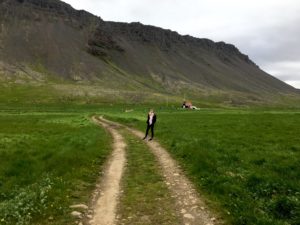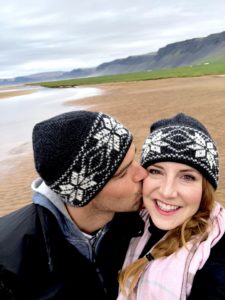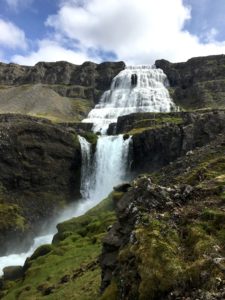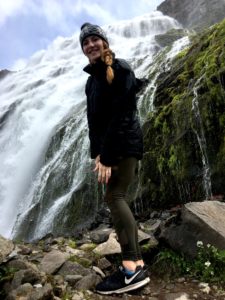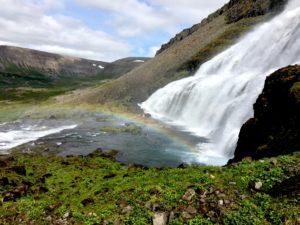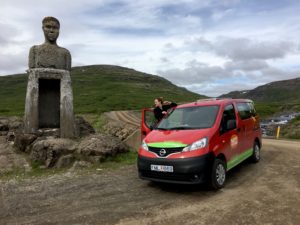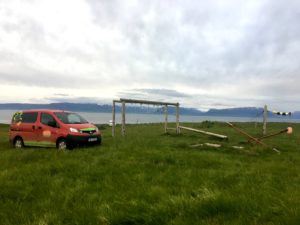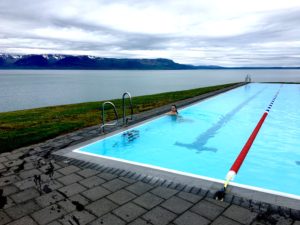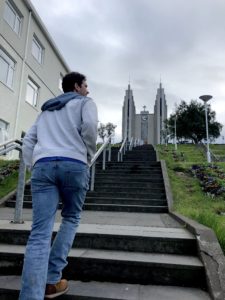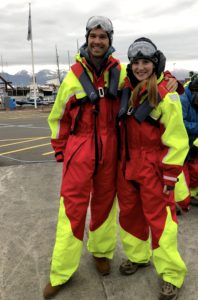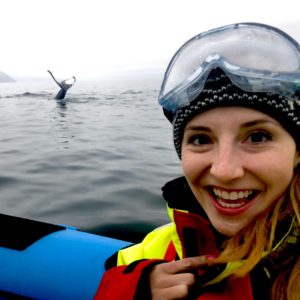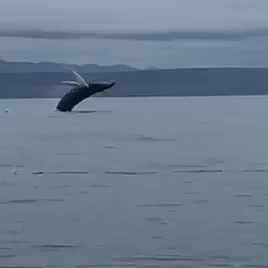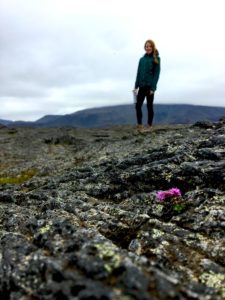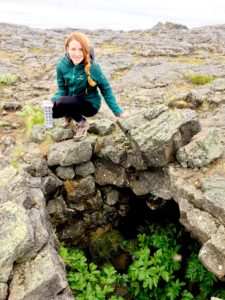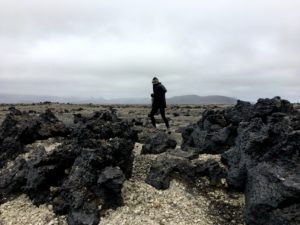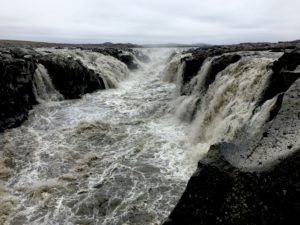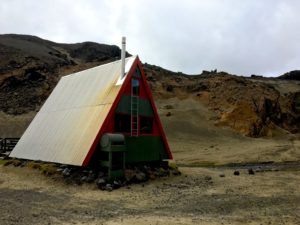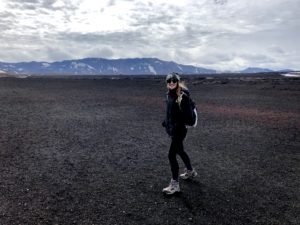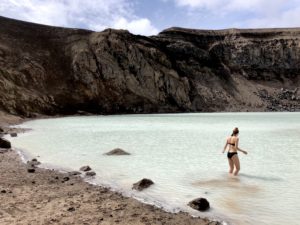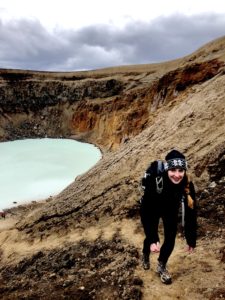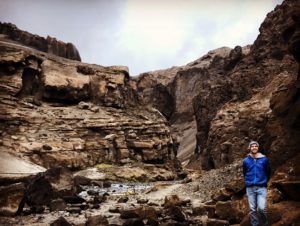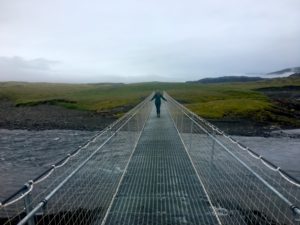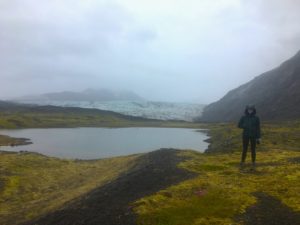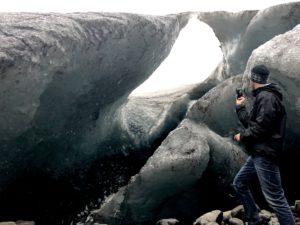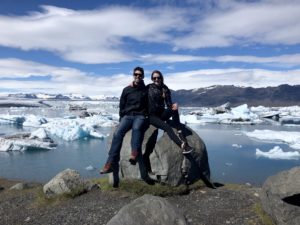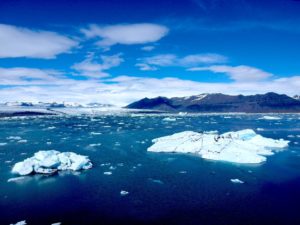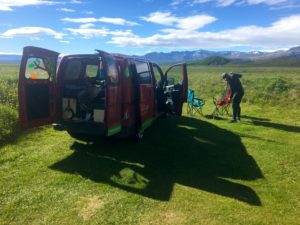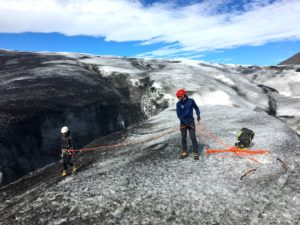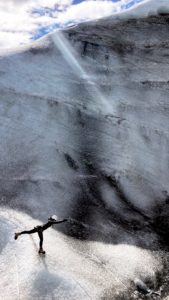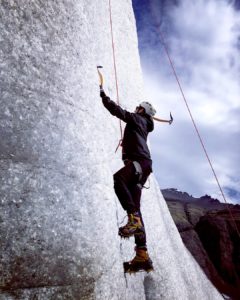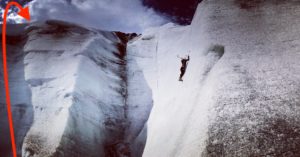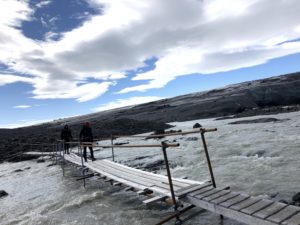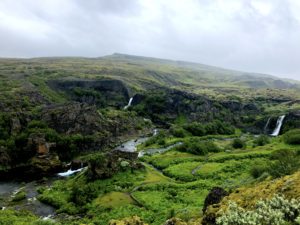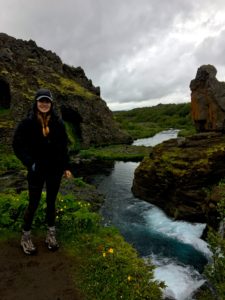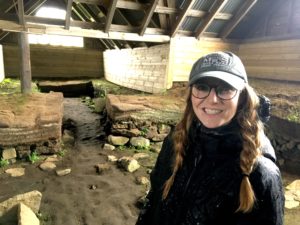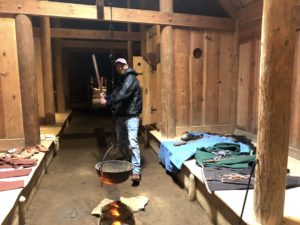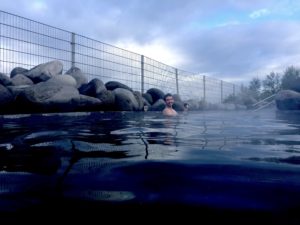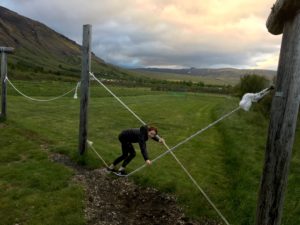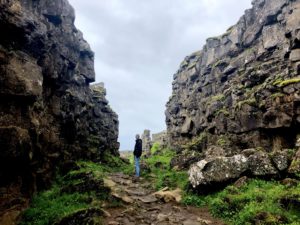I know that Iceland is a trendy destination these days and some of you can’t be bothered to read this entire blog post, so TL;DR below.
- Best camping: Melanes (Westfjords), Grettislaug (North Iceland), Haukafell (East Iceland), Svinafell (South Iceland)
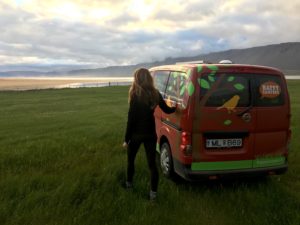
- Best hot springs: Krauma (North of Reykjavik), Hofsos (North Iceland), Fontana Springs (East of Reykjavik)

- Best adventures: whale watching in Husavik (North Iceland), moonwalking at Askja and extraterrestrial swimming at Víti (North Iceland), ice climbing at Vatnajökull (South Iceland)

For those of you with more patience and interest, read away!
After our last successful voyage to a certain string of volcanic isles in French Polynesia, Tori and I set our sights to the north. She was scheduled for five-days hard labor in Reykjavik with her account team at Autodesk, so we thought it to be only natural that we arrive a few days early for regional reconnaissance. While tropical paradise it was not, we had a great time absorbing the otherworldly sights of Iceland.
Before our last trip, I read every book I could find on exploration in the South Pacific, watched a fantastic BBC documentary on the wildlife across each island chain, and did my best to learn everything I could about Polynesia, its history, and its place in the modern world. This time, I did none of that.
Preparing for a trip to Iceland is challenging in the absence of any distractions. Place names are unpronounceable for all but native Icelanders. The tourism industry is at once both over- and under-developed. The well-traveled sites surrounding the capital are insanely oversampled in the travel literature as compared to the rest of the country, making it very difficult to plan a full-island itinerary. Geography is totally unfamiliar. Rattling off two cities in almost any country in the world is easy. I challenge anyone to name a second city in Iceland. While these factors could possibly have been overcome on their own, we had the added pleasure of moving, starting a new job, and beginning to plan for our wedding.
This haphazard preparation meant we landed in Reykjavik with nothing more than Happy Campers van reservation and mandate to return 10 days later. And I do mean nothing. Our friends at Air Canada forgot our luggage in Toronto so our earthly possessions were limited to the clothes on our backs, which unfortunately did not include rain jackets as it was pouring. And thus began our wonderful trip.
You can follow our itinerary using the map below or open a full-screen window here. Each color represents a different day. We traveled clockwise, a decision I would recommend to all who follow in our footsteps.
Day 1: Keflavik to Tjaldsvæði or welcome to Iceland–I hope you came prepared for freezing rain
As I mentioned, we arrived in Iceland totally unprepared. I skimmed through the Iceland Lonely Planet guide, but all the place names were muddled in my head and I really couldn’t figure out what one did in Iceland. As far as I was concerned, the country was an entropically dispersed collection of glaciers, fjords, and hot springs. I had also heard Iceland was unreal from nearly my entire social circle, so I figured we didn’t need to do to much work.
I began to doubt myself as we approached Keflavik International Airport. Fog and rain stretched across a desolate plain as far as the eye could see. Sad-looking shrubs clung to barren lava formations as freezing wind threatened to spirit away their foliage. I saw no fjords. No hot springs. No glaciers.
Upon landing, we stocked up on booze in the Duty-Free, as one is advised to do given the usurious prices of alcohol on the island, grabbed our baggage, jumped in the Happy Campers shuttle, and prepared to brave the elements. Except the middle two didn’t happen. After watching the conveyer belt lap its track for what seemed like hours, we learned that our warm clothes and rain gear did not make it to Iceland. And somehow wires got crossed and our Happy Camper shuttle was nowhere to be seen. The latter was dealt with immediately via a quick Twitter DM. The former was more complicated.
Wearing our plane clothes and laden with carry-on bags full of Duty-Free whiskey and other useless niceties, we briefly stopped in the Happy Campers office to learn about the multitude of ways we could be charged obscene amounts of money for damaging their van, and set our sights to the north.
Why the north? We flipped a coin while driving away and clockwise came up. Most Icelandic road trippers travel the island counter-clockwise, but I would wholeheartedly recommend our approach. As you will read in this blog post, the northern parts of the country are largely untouched by humans and provide the biggest views the country has to offer while the south is clogged with tourists and home to the classic Icelandic sites. On trips, I always love to start rugged and transition into lux as the trip proceeds. The clockwise direction somewhat follows this model.
Our first stop on the Odyssey was Glymur waterfall, the tallest in Iceland at 198 m. It was here where we first began to understand why people visited this desolate rock in the middle of the North Atlantic. The trail up to Glymur is simply spectacular. It follows the Botnsá River through its narrow canyon, up to the falls, and into to a swamp up top. Big views and huge photo opps were found around every corner with sheer drops, birds nesting, hints of the waterfall, hidden caves, and volcanic formations. I couldn’t recommend this hike more.
Precarious bridge en route to Glymur
Glymur falls
Above the clouds on the way down from Glymur
The valley beneath Glymur Falls
Three or so hours later, we were ready to unwind at our first Icelandic hot spring. Krauma is a brand new facility with beautifully constructed baths of various temperatures, a wood-fired zen sauna, and an amazing staff. This is the best hot spring in all of Icleand, so take note. You would be crazy to visit Iceland and not stop here. After a good soak and a few glasses of wine, we crossed the street and camped at Tjaldsvæði, a mediocre field whose only attraction is proximity to Krauma.
Day 2: Tjaldsvæði to Melanes or our first foray north of the wall
While our first day in Iceland was sprinkled with freezing rain, the sun did peek out from behind the clouds for a few moments over Glymur Falls with spectacular results. Day two was our first of many days of real Icelandic rain. We awoke to droplets pounding the top of our camper and every interior surface dropping with condensation. After an awkward dance to change and pack back up without getting soaked, we continued north.
Our original plan was to climb Snæfellsjökull, the highest peak on the Snæfellsnes peninsula in western Iceland, but the rain foiled our plans. Rain also reminded us that we were still without raincoats or boots. I accepted that my one change of clothes would just be permadamp, but we preferred not to be permasoaked. After a barrage of apparently persuasive Twitter messages, Air Canada gave us a $500 allowance to buy new clothes until our luggage arrived. $500 doesn’t go far in Iceland, but we pointed our van toward the nearest town, Stykkisholmur, and picked up some rainwear.
While there, we noticed a peculiar ad for Icelandic sushi tours. We figured a boat tour would be better than a glacier walk in the spitting rain, so bought tickets and hopped aboard. Our stoic Old-Man-and-the-Sea tour guide piloted us to within striking distance of various shards of volcanic rock shivering in the bay and we began to make our first Puffin sightings!
Puffins are the unofficial mascot of Iceland and look nothing like I imagined. They are rotund seabirds that speed most of their lives bobbing the ocean. Their wingspan is so short relative to their portly bodies that they always appear to be frantically flapping to avoid falling out of the sky–think clumsy hummingbird. Their method of getting airborne is manically flapping their stubby wings while slapping their feet against the water. More than once, I saw a poor, graceless Puffin catch its foot while taking off and faceplant into the water. To land, the birds do the whole dance in reverse. Rather than gracefully decelerating like their Plover and Tern brethren, Puffins simply spread their wings, stall, and splat against whatever surface beckons.
After a few quick stops to learn the few bits and pieces of Icelandic folklore, it was time for Viking sushi. The crew lowered a dredge off the back of the boat, let us drift for 15 minutes, and raised it with a hoist, raising a claw full of rocks, clams, sea urchins, and other bottom dwellers. For the Sierra Club members out there, this was the first time I witnessed the collection of shellfish in person and it is definitely not good. Wantonly scraping up the bottom of the sea seems like not a good sacrifice for eating scallops. That said, the scallops were darn good raw and I learned that sea urchin roe is something I never want to eat again as long as I am on this fine earth.
Only scallop roe remained. The delicious raw muscle always went first.
Full of scallops, we explored the lighthouse overlooking Stykkishólmur, took some pictures of the spectacular scenery, and headed north. Most tourists in Iceland skip the Westfjords, the sparsely populated northwest region of Iceland that extends farthest from the ring road. We were planning on being most tourists, but our stoic concierge at Happy Campers convinced us that that would be a mistake. He was right.
The geometric patterns of the volcanic plugs conjure images of Devil’s Tower in Wyoming
This lighthouse keeps watch over Stykkishólmur.
While long, the drive was spectacular. For the Californians reading, think Yosemite mixed with Big Sur. The road wound up and down from the desolate volcanic plateau atop the fjords to the sheer cliffs nearly touching the ocean. I’ll let the photos do the talking, but along the way we stumbled upon all kinds of curiosities left without explanation. Shipwrecks, abandoned construction sites, tiny fishing villages, natural hot springs, and bizarre stone statues all kept us interested. In addition, the road to the Westfjords varies from perfectly sealed to Dakar-esque dirt switchbacks decorated with potholes large enough to swallow the little 12″ wheels of our camper van. Tori never really let me uncork, but the vast scenery and winding roads couldn’t help but draw me into a rally racing fantasy, especially when I saw the WRXs and Super Jeeps race by. They were obviously having fun.
Reykholar serves as the gateway to the Westfjords
Reykholar is so beautiful, I thought it deserved two photos. The world’s most spectacular disc golf course is just out of the frame to the left.
We found an interesting statue shortly after leaving Reykholar.
Monuments to this gentleman are scattered across the Westfjords. Notice how quickly the landscape changed from lush to barren as we climbed on top of the plateau.
Shortly before arriving at Melanes, we found a ship that had run aground. This photo was taken around 10 pm and with still plenty of sun left in the sky.
Our objective for the night was the campground at Melanes, situated a few miles from Rauðasandur Beach, an endless stretch of pink sand abutting a few hundred feet of vertical cliff. We were not disappointed. Our night set the expectation that Icelandic campgrounds were fenced in paddies not too dissimilar to American RV parks. Melanes was not. This could be the most beautiful campsite on Earth. The sea and pink sand lay to the south, the cliffs and babbling waterfalls to the north, and lush green grass as far as one could see to the east and west. Aside from the 50-degree temperatures, we were in paradise.
Horsing around Melanes. This photo was auspiciously taken at 11:11:11.
Day 3: Melanes to Grettislaug or our two-day streak of the most incredible campgrounds on earth
Waking up in Melanes was breathtaking. The sea, the cliffs, and the beaches were just as we left them. In what would be become a well-oiled morning ritual, we made ourselves breakfast, packed up the van, and set off for Rauðasandur Beach. We were not disappointed as we hiked the mile-long trail from a quaint white churchhouse, through an electric green paddy, and to the beach glistening with shallow pools of water, giving Rauðasandur the appearance of the famous Bolivian salt flats.
Marching from the cliffs to the beach
Rauðasandur Beach
From there, we knew we had to make huge progress if we were to lap the entire island. We had been driving for three days and had made negative progress around the ring road due to our detour to the Westfjords. We could have spent our entire vacation exploring this region, but we felt like we had to continue onwards to see what we were missing. This turned Day 3 into a one of transit, albeit through some spectacular country.
Our first and only real stop along the route was at Dynjandi Falls, also known as the jewel of the Westfjords and a really spectacular National Park. The falls were a short detour off of our planned route and we kept thinking we spotted them, only to continue seeing bigger and bigger falls. When we finally arrived, we were blown away by their magnificence.
The photo was taken close to the base of Dynjandi Falls. All five steps are so massive that capturing them with a camera is nearly impossible.
Tori and the upper fall
A rainbow appeared on our way down
The rest of the day was a blur of up, down, and around to get back on schedule. Between stopping every 30 minutes for some awe-inspiring vista and driving slowly to avoid losing our little van to the gods of rally racing, we spent the rest of the day winding our way over to Grettislaug, the second best campsite of the trip.
Our intermittent Westfjord travel companion bid us adieu as returned to the mainland
Tucked ten kilometers off the 1 down a washboard single-lane dirt road, Grettislaug is a must-visit. The campground sits on the end of a peninsula jutting out into the ocean and boasts an amazing natural hot spring that affords 360 views of the ocean and the mountains separating the Grettislaug from the hustle and bustle of the rest of north Iceland (lol). The kitchen and bathroom are built in true Viking style with grass roofs that extend all the way to the meadow. After a quick dip in the springs and another home-cooked meal, we called in a night with whales leaping through our dreams.
Playgrounds are a thing at picturesque Icelandic campsites
Day 4: Grettislaug to Mývatn (Reykjahlíð) or I had no idea whales could jump so high
Our planned objectives for the day were to take a dip at the legendary springs Hofsós, stroll around Akureyri, Iceland’s second city and capital of the north, experience the celebrated whale watching in Húsavík, and stage ourselves for the trek to Asjka. We accomplished all with uncharacteristic efficiency.
Our guide at Happy Campers told us if there was one thing to do in Iceland, it was to go swimming at the pool in Hofsós. Yet, this pool was not notable enough to make it into the Lonely Planet book. Clearly, there was some ongoing debate about what characterized a must-see attraction in Iceland. The truth was somewhere in the middle. The Hofsós pool is more Rio 2016 than Blue Lagoon, but we did take advantage of being able to swim laps until our arms fell off while taking in endless ocean views from the hot tub while we recovered. Our timing didn’t quite work out, but it is possible to schedule a night time swim, which could have been even more spectacular.
Training for Tokyo 2020 at the Hofsós pool
We worked up such an appetite swimming that we stopped for lunch in Akureyri. It was kind of jarring to arrive in a proper town again (pop: 18k) with complicated parking rules and more than one cafe, but we reacclimated rapidly. After poking our heads into a few shops and walking up the hill to the cathedral, we drove to the botanic gardens. This is a must-see for anyone who likes gardening. Aside from being shocked at how many tropical flowers seem to flourish in the frigid Icelandic summer, I really enjoyed exploring the artic exhibits. Learning about the beautiful little flowers that thrive in the world’s harshest conditions was totally unique and the fact that the Colorado Columbine made the cut was icing on the cake.
Walking up the stairs to the famous Akureyri cathedral
Finally, it was off to Húsavík, as far as I know, the whale watching capital of the world. Because of our extremely limited preparation, I had no idea what to expect. We walked through the whale museum ahead of our departure time and I learned that all kinds of whales come to Iceland. Orcas, Sperm Whales, and Blues have all paid visits to the Icelandic coasts.
When I boarded our dinghy, I was a little disappointed to learn from our guide that the bay north of Húsavík is too shallow for Sperm Whales or Orcas and the Blue Whales passed through a few weeks ago. Worse, the Humpback mating season had come to an end, so the whales would be particularly docile.
Did I mention Iceland is cold and rainy? Our warm weather gear for whale watching was fit for the artic sea voyage.
And then we got there. I learned that whale watching in California is not like whale watching in Iceland. My previous best whale watching experience was off of Moss Landing when I encountered a handful of Humpback Whales while kayaking. The whales chased baitballs orbiting our little pod of kayaks and emerged every now and then to wave a fin. I thought it couldn’t be beat. I was totally wrong. In Húsavík, we saw hundreds of Humpbacks putting on a show that could’ve sold out at Sea World. We saw a family of whales teaching its calf to breach, we saw lunge feeding, we saw fluke-up dives, we saw tail slaps, and we even saw a few whales wave us goodbye as we headed back to shore. This experience was so incredible that Orcas and Blues became a distant distant memory.
We found a whale!
What could be cuter than a baby whale breaching?
After the show, we drove straight to Reykjahlíð. Because Mývatn is the tourist capital of the north, the campsite was slammed. Giant RVs parked semi-permanently monopolized the good spots, so we were stuck squeezing off the side of the road behind the bathrooms. There are two campsites in Reykjahlíð. One is spacious and on the lake. The other is cramped and not. We chose the former. Don’t want the same mistake.
We ate dinner at the fantastic Vogafjós Cowshed Cafe. They serve Icelandic farm-to-table meals and will serve you a glass of milk straight from the udder of one of the cows relaxing in the shed attached to the restaurant. Bellies full, we headed to bed ready to conquer Askja.
Day 5: Askja and Víti or life on the moon
The Icelandic Highlands are treacherous. Apollo astronauts trained here to replicate the lifeless conditions found on the surface of the moon. Volcanoes erupt frequently. Rain rarely falls. Winter storms wipe push any trace of life underground. For some reason, this was the only place in Iceland I absolutely had to visit.
To get our taste, we hitched a super Jeep tour up F88, a road we were absolutely forbidden to follow in our rental contract, up to Askja, a massive caldera that now contains a glacial lake, and Víti, an electric turquoise hot spring abutting.
We hopped in our super Jeep, in this case, monster off-road school bus rocking 35″ tires, and began climbing. Our first stop was at Herdubreidarlindar, a remote mountain camp that once served a hideaway for Iceland’s most famous bandit. After stealing a sheep, he refused to run himself in so lived in the Highlands for years before being brought to justice. He built a small cave over a running stream and survived for the winter on stolen sheep meat and vegetable roots. Even in the middle of the summer, the feeling of desolation and sterility is so strong in the highlands that I couldn’t imagine what this bandit went through.
Silene acaulis clinging to life
Tori contemplating spending a winter in Iceland’s most famous hideout
After confirming we did not want to follow in his footsteps, we stopped at an Apollo training field. The vast expanse of volcanic gravel and boulders provided the perfect environment to test agility and dexterity ahead of the lunar landing. The flat, more or less featureless, horizon also simulated the scale illusions the astronauts would face on the moon. Just as the diameter of moon rocks vary by three or four orders of magnitude due to minimal erosion, the huge size distribution of the frequently replenished igneous features makes estimating distance incredibly challenging.
Moon rocks scattered about
After playing on the moon, we forded our first river. Up until this point, I was confident our little van could take everything that F88 could dish out. The four-foot deep river crossing changed all of that.
Our super Jeep forded this river. I can see why Happy Campers asked that we avoid F88.
Across the river, we continued climbing to a small research station and museum that greets tourists and houses scientists studying the geology of the area, parked, and continued the rest of the way on foot.
Lonely living a few miles from Askja
The hike to Askja was literally out-of-this-world. Volcanic spires begged to be climbed. Endless flats of melted glass distorted all sense of scale. Craters needed exploring. While walking to the caldera, every step was an adventure. I don’t know if it was just an illusion, but the ground felt eerily hollow below our feet like an eruption could explode or the caldera swept beneath us and was waiting to collapse at any moment.
Featureless volcanic desert
When we crested the hill and saw Askja and Víti, our senses entered some kind of unfamiliar state. Seeing this kind of lake in this kind of landscape was so novel that our struggling neurons weren’t quite sure how to comprehend the situation. Fortunately, new connections were rapidly forged and we hiked around Víti, enjoyed our lunch, and plotted the route to the bottom of the crater.
Askja and Víti
Between the bubbling vents, ice hiding in the shade, loose sand, and extremely steep slope, there are only a few ways down. We picked what seemed like the best one and put one foot in front of the other. Aside from couple Frenchmen, we had the pool to ourselves. Swimming around a bright turquoise crater in the middle of the Icelandic Highlands was totally surreal. All those laps in Hofsós paid off as we swam from deceptively long end to the other.
Taking a dip in Víti
Climbing out of Víti
We made the trek back to the super Jeep to arrive dead last in our group. Apparently, the rest of the team didn’t enjoy climbing the extinct volcanoes as much on the way back. We retreated whence we came, stopping once more to hike up Dragon Canyon, a bizarrely situated red canyon awkwardly emerging from the otherwise monotonous landscape.
Dragon Canyon
Twelve hours after we started, we returned to Mývatn, took a quick dip in the Nature Baths (skip them), and called it a night.
Day 6: Mývatn (Reykjahlíð) to Haukafell or what to do in Iceland when it’s raining sideways
While we hadn’t seen the sun for more than a few hours since we arrived in Iceland. It had been more or less spitting constantly, we had been thus far spared of true, tropical style rain. Until now.
We woke up to rain that would make Forrest Gump proud. We had big plans to explore the Eastfjords on horseback, but there was no way in this weather. In a ritual that became second nature, we looked at the forecast and noticed that it would clear up further south later in the evening, so we just pointed the compass south and started driving. I can’t say much about east Icleand, because I honestly didn’t see much of it. Visibility was around a hundred feet and the pathetic wipers on our van limited me to a few streaks on the windshield.
We stopped in Höfn for lunch to stretch our legs and regroup. We had the unexpected pleasure of wandering into Otto, a new restaurant in town started by an entrepreneur who wanted to escape the hustle and bustle of Reykjavik, to sample the best menu in the country. Höfn is known for langoustine, what you might call Icelandic crayfish, and our hostess at Otto knew how to make them. The soup and the main dish were both phenomenal. Three hours and a few glasses of wine later, it was still pouring, but we set out to find our campground. There are several options in the Höfn environs, so we stopped by the tourist information center to get a recommendation. Hilariously poetic in the freezing rain, we were greeted by a sullen Icelander greeted who let us know that he didn’t like camping and was surprised we were traveling in this kind of weather. We were on our own.
We threw a dart at the map and chose Haukafell and what a throw it was. Unlike most of the private campsites, Haukafell is in the middle of a national park and operated by the government. No frills were to be found, but the campsite lies just in front of a massive glacial river that leads to Fláajökull tongue of Vatnajökull. Catching our first glimpse of the glacial blue meandering down from the highlands into our backyard for the night, we knew we had picked the right spot.
The rain had let up enough to venture outside, so we followed one of the park’s many trails in the direction of the glacier. Minutes turned to hours, lush vegetation turned to volcanic rock, and we finally arrived beneath the massive frozen archway that signaled the end of the glacier. Delusions of a glacier walk quickly evaporated hearing multi-ton blocks of ice creaking under strain. Avoiding certain death, we turned around and walked back to the campsite knowing we would return with tools in a few days.
Crossing the torrent in pursuit of the glacier
The glacial tongue was in sight
We finally made it to the glacier
Day 7: Haukafell to Svinafell or I’ve never been more excited to see the sun
We woke up to a novel sound. Silence. Sliding open the door of the van, it seemed too good to be true. Water was not falling from the sky. The clouds were still threatening, but in the tiniest corner of the horizon and saw a blue that had been missing for 5 days. After a leisurely breakfast and coffee that let us stretch out beyond the confines of our van, we set off for Diamond Beach and Jökulsárlón Lagoon.
This was quite the spectacle. We had read over and over at how tourism has dramatically impacted life in Iceland and how important it is to tread lightly. We took the latter to heart but saw essentially no sign of the former until this point. It was at Jökulsárlón Lagoon where we first saw the aftermath of the cheap trans-Atlantic Iceland Air flights that deposit travelers in Reykjavik for a few days. The Lagoon is close enough to the capital to draw hundreds of day-trippers in tour buses. The parking lot hinted at a suburban Wal-Mart on Black Friday over which dozens of tour companies flew bright banners advertising their services.
Blue skies!
That said, the lagoon is truly spectacular and made even more so by the bright artic sun that finally decided to make our acquaintance. And the groups can be totally avoided with a short, scenic walk. As we walked around the edge of the lagoon, we were totally taken aback by the contrast between the frozen calm and sudden chaos of an iceberg cracking. Yacht-sized blocks of ice would suddenly come roaring up from the deep and crush anything in their way. The icebergs meandered their way from a glacial tongue, through the lagoon, and out to sea. As they approached the narrow channel sweeping them out to sea, they accelerated in the current and we watched a thousand-ton game of bumper cars play out as these massive slabs of ice violently bashed into one another.
Icebergs as far as the eye can see
Once the icebergs make it out to sea, the current pushes them back to Diamond Beach, just outside the lagoon. They then shatter into little (or big) pieces and sit on the black sand like diamonds. While it certainly wasn’t even California beach weather, we basked in the sun and enjoyed the scenery.
We typically rolled into campgrounds late because the sun never set and there was so much to see and do. Day 7 was different. We saw the gorgeous Svinafell campground (note: definitely stay here and not the one a few kilometers down the road), set up camp at 4 pm, and replenished our vitamin D reserves. As we were enjoying our early afternoon wine and sun, our neighbors, a Canadian mother and daughter, invited us over for happy hour. Eight hours later we still hadn’t run out of things to say. They were as curious about our ordinary life in the SF Bay as we were theirs on a massive farm in rural Saskatchewan. Meeting new people is definitely one of the beauties of traveling.
The beginnings of a happy hour in Svinafell
Day 8: Haukafell to Hvolsvöllur or ice climbing rocks
Today was the big day. Tori has wanted to go ice climbing since we landed in Iceland and through sheer determination and persistence, she was able to convince an outfitter to take us. Ice climbing is one of those activities you see pictures of everywhere, but every guide tries to shunt you to an ice walk. Tori couldn’t take no for an answer and got us a date and a time.
It was also a big day because it was sunny. The great weather from the previous day had carried over. When we originally booked, I was worried we would be in for a miserable time on the glacier in the rain, but the weather could not have been better. We met our guide at HQ, hopped in his super Jeep and set off for the Breiðamerkurjökull finger of the Vatnajökull glacier. While navigating the rough rode, our guide let us know he had just returned from Italy in the midst of a quest to climb the tallest peak in every country in Europe. It was cool to hear his stories and learn how he transitioned climbing in rock gyms in pancake flat Belgium to working as an international mountain guide who bagged a first ascent of Skógafoss, one of Iceland’s most famous waterfalls.
We arrived at the glacier and started walking. In no time, our trip transitioned from mellow glacier walk to crampon-required roller coast between massive crevasses that had opened up over the last few weeks. We roped up and belayed to the edge of one to have a peek inside and were totally taken aback by the deep blue beauty of these windows into the glacier. After confirming that lowering into the crevasse and climbing back out would not have been the safest first climb for a couple n00bs, we continued on until we found a nice-looking open face.
On belay and peeking into a deep crevasse
Our guide gave us a brief tutorial that would probably be more appropriate for indoor bouldering than vertical glacier ice, hiked around the side, and set an anchor up top. Tori was up first. Watching her methodically kick and ax her way up the face made it look easy. When my turn arrived, I learned the contrary. By the team I reached the top, I could barely hold on to my axes, my toes were cramping, and I had no desire to every ice climb again. Fortunately, our wise sensei immediately noticed that we were both holding the axes with an iron grip and kicking like we were in the middle of a Muay Thai ring and showed us the float-like-a-butterfly method. This immediately set in and we both raced up the second pitch.
Tori practicing glacial yoga before her first ascent
Me swinging my axes way too hard
From there, we were ready for a challenge. How about an overhang? Because our rope was not long enough, we set our anchor up top and discussed how we would lower down the overhang and signal belay instructions out of visual and auditory range. Two ice screws later (I am no champion mountaineer, but I have taken a physics class or two and three separated by 10 feet or so would have made me much more comfortable than two six inches apart), I was on belay and getting lowered into the abyss. I briefly had flashbacks to my first time rappelling off of the Third Flatiron in Boulder, where I stranded my dad on the summit as a lightning storm rolled in because I refused to transition into the free rappel, but fortunately, they did not take hold. Seconds later, I was on solid ground out of sight and sound from Tori and our guide.
Clumsily signaling that was ready for belay with rope slaps, I began climbing. The first 10 meters were easy and not quite vertical. Then I hit the step. Normally, climbing around an overhang requires incredible trust in the placement of your axes because you really can’t see where they set. This situation required even more because I had no confidence that our anchor would hold. Fortunately, I had to test neither and made it to the top safe, sound, and full of adrenaline. My zen lessons went out the window. I had been gripping my axes so tightly that it required a second hand to physically uncurl my fingers and release them.
Tori’s first ascent along with our overhang route marked in red
Death defied, we began the hike back down, both elated that we had climbed a glacier in Iceland. Just the experience was surreal and getting a chance to explore some of the more technical areas was a total blast.
Triumphantly returning from ice climbing
By the time we returned to base, the clouds had assembled on the horizon. Our 24 hours of sunlight were to come to an end. We had big plans to visit the beautiful black beach at Vík and the stone pillars of Reynisdrangar, but spitting rain and freezing wind significantly diminished the appeal. We made a quick stop at each, understood how beautiful these places would have been in better conditions while watching a miserable family try to stay warm on a beach-side horseback ride, and drove toward Hvolsvöllur.
Hvolsvöllur was quite a mediocre campground, but we had the good fortune of meeting two other couples embarking upon the same trip in reverse. 750 mL of Crown Royale later, we were all friends and vowed to stay in touch forever.
Day 9: Hvolsvöllur to Laugarvatn or Viking ruins for days
Day 9 was another rainy one. We again were awoken by droplets drumming on the aluminum roof, giving us a pretty strong signal that we wouldn’t be enjoying a sunny day at the beach on Vestmannaeyjar, a must-visit in many Iceland books. We checked the radar and noticed that we had the best chance of avoiding the downpour if we drove to the north, stopped at some of the sites on the Golden Circle that were probably more rain agnostic, and skipped the rest of the southern coast.
As I started assembling our route, I strung together a spur to the largest Viking ruin at Stöng, a stop at Geysir, and a dip in Fontana Springs. Despite the last-minute change of direction and disappointment that came from missing Vestmannaeyjar, I wouldn’t have done this day any differently.
Many of the drives off (and sometimes on!) the ring road are simply spectacular in and of themselves. Driving north to Stöng, we passed through quite a few midsize Icelandic villages that reminded me of where I lived in Switzerland–angular churches at the center of town, nicely cobbled streets, quaint-looking farmhouses. While meandering through the countryside, we took an abrupt turn up the Þjórsá River where the landscape turned barren. The lush green was replaced with martian rust and soon we found ourselves turning onto a dirt road marked impassable for 2WD vehicles.
The only guideline we got from Happy Campers was to stay off the F roads. There was not an F in sight on the 327 road sign, so we forged ahead. Worst case scenario, I knew that we could reverse all the way out. The road started relatively flat and rutted but rapidly turned sloping and rocky just as another wave of rain started falling. Puddles grew and rocks brushed perilously close to the undercarriage as we picked our way closer to the ruins. My fingers were crossed that the Icelandic mud gripped better than its counterpart in Utah. After cresting a hill, we finally spotted the parking lot a kilometer down a steep hill. Without knowing whether we would make it back up or not, we embarked upon the descent.
We pulled into a lot populated exclusively by super Jeeps and offroad vans. The road continued across a now raging river, but there we no way our little camper could make it across. Knowing we were only a mile or two from the ruins, we elected to hike the rest of the way. We followed a trail down from the plateau and in steps, we transitioned from igneous wasteland to Elvin paradise. Somehow the waterfalls around Stöng didn’t make any of the guidebooks, but I felt closer to a Thomas Kinkade painting than I ever had in my life. I was honestly surprised that the Icelandic trolls weren’t still living in their little grass houses at the base of the valley.
Falls just outside Stöng
I may have saturated this photo too much in post, but this water was the deepest azure I have ever seen.
Once we arrived at Stöng, we explored the knee-high foundation for a few minutes and called ourselves Viking-ologists. Unlike many famous traces left by ancient civilizations, you have to be into the Vikings before appreciating the (small) marks they left behind. The Red Fort, Tikal, the Great Wall of China, and the like are all simply impressive human accomplishments. The scattered stones at Stöng are probably only of interest for the most die-hard aficionado of Icelandic history.
The ruins of Stöng in all of their glory
Retracing our steps (spoiler: Icelandic roads do not get slippery when wet and we made it out fine), we set off to Geysir. En route, Tori noticed a strange house built into the side of the hill. In no rush, we turned off the road to take a look. Sure enough, the Icelandic historical society has taken the liberty of rebuilding the site at Stöng and populating it with replicas of the era. We took a quick lap through, coming to the same conclusion about the replica as the real thing, except learning that the replica was featured in Game of Thrones, and sped away.
The exact same position in the recreation
Geysir is like a mini-Yellowstone attended to by the German version of the road tripping American tourist. If you have seen Yellowstone, feel free to skip. We saw on eruption and headed to the springs.
Our last stop for the night was at Fontana Springs. At this point, we had seen the gamut of Icelandic hot springs, but this one was up there. The springs were directly on Laugarvatn, so bathers could jump from freezing lake to sauna to hot bath to warm bath to steam room and back again. I enjoyed a few laps and then we made camp a few blocks away.
Relaxing in Fontana Springs
The campground would have been unremarkable except for the super fun obstacle course that entertained us before bed. Don’t ask how many times we fell off…
Tori navigating one of the rope challenges
Day 10: Laugarvatn to Reykjavik or back to civilization
We woke up refreshed in Laugarvatn after our relaxing evening navigating the obstacle course. We drove straight to Þingvellir with wind in our sails knowing that we would be swapping the camper van for a night in a hotel with running water.
Þingvellir, pronounced thing-vellir, was the capital of Iceland until 1798, sits on top of a continental fault, and is absolutely overrun with tourists. The geology is incredible. Seeing parallel trenches carved into the earth descend to the depths of a crystal clear lake is quite something. The history is interesting. While early Icelanders didn’t build up the awe-inspiring infrastructure of other cultures, Þingvellir is decorated with signs sharing Icelandic lore and there are a few piles of stones to look at. The crowds, however, were unbearable. Stopping through at midnight is highly recommended.
Between two plates at Þingvellir
Back on the road to Reykjavik, we stopped to vacuum out the car only to learn that Icelandic gas stations all offer the power washers and brushes that cost a buck a minute in the US for free. The van was absolutely covered with mud and dirt from all of our offroad adventures, so we did out best to make it look brand new (all of the camper van companies are notorious for trying to extract damage fees upon return) and wandered back to the Happy Campers HQ.
Tori was staying in Reykjavik for the rest of the week, but I had to get my fill in in a single day. Fortunately, the town is tiny and I didn’t see much that interested me on the tourist map. Forgoing the art and Viking museums, we grabbed a drink with Tori’s colleagues downtown and spent the evening debating Facebook, free speech, and communication in society. After a bar crawl that probably slightly pushed the boundaries of what’s appropriate at work, we called it a night and I caught the next flight back to San Francisco, dreaming of our next trip as I watched Iceland disappear beyond the clouds.
